Translate this page into:
Current Status of Percutaneous Transhepatic Biliary Drainage in Palliation of Malignant Obstructive Jaundice: A Review
Address for correspondence: Dr. SH Chandrashekhara; E-mail: drchandruaiims@yahoo.com
This is an open access article distributed under the terms of the Creative Commons Attribution-NonCommercial-ShareAlike 3.0 License, which allows others to remix, tweak, and build upon the work non-commercially, as long as the author is credited and the new creations are licensed under the identical terms.
This article was originally published by Medknow Publications & Media Pvt Ltd and was migrated to Scientific Scholar after the change of Publisher.
Abstract
Malignancies leading to obstructive jaundice present too late to perform surgery with a curative intent. Due to inexorably progressing hyperbilirubinemia with its consequent deleterious effects, drainage needs to established even in advanced cases. Percutaneous transhepatic biliary drainage (PTBD) and endoscopic retrograde cholangiopancreatography (ERCP) are widely used palliative procedures each with its own merits and lacunae. With the current state-of-the-art PTBD technique consequent upon procedural and hardware improvement, it is equaling ERCP regarding technical success and complications. In addition, there is a reduction in immediate procedure-related mortality with proven survival benefit. Nonetheless, it is the only imminent lifesaving procedure in cholangitis and sepsis.
Keywords
Biliary stenting
Endoscopic retrograde cholangiopancreatography
Obstructive jaundice
Percutaneous transhepatic biliary drainage
INTRODUCTION
Obstructive jaundice can be of benign and malignant etiologies. Of the malignant causes, carcinoma gall bladder, cholangiocarcinoma, pancreatic adenocarcinoma, metastasis, and lymph nodal compression of common bile duct (CBD) constitute the majority of cases.[1]
Most of the cases of malignant obstructive jaundice are already advanced and unresectable by the time they are diagnosed, hence carry dismal prognosis with palliation being the only option left. Obstruction needs to be drained even in such cases for alleviation of pain, cholangitis, and pruritus or in certain cases to initiate chemo or intrabiliary brachytherapy. Over the years, palliative care has evolved with the introduction of newer methods and improvisation of existing techniques. Recent palliative measures not only prolong longevity but also improve the quality of life, hence increasing the acceptance to such procedures.[123]
Methods of biliary drainage include:
-
Surgical bypass
-
Minimally invasive procedures
-
Endoscopic retrograde cholangiopancreatography (ERCP)
-
Percutaneous transhepatic biliary drainage (PTBD).
-
Both ERCP and PTBD are well-established and effective means of biliary drainage for palliation in unresectable cases. With increased technical success rate and expertise in these minimally invasive procedure, recent time has witnessed an exemplary surge in the demand for such procedure over surgical bypass. Selecting an option over other; however, is a multidisciplinary opinion, which not only involves expertise of operator and the site of obstruction but also takes into consideration other factors such as expected survival and the level of postprocedural care provided to the patients. ERCP is usually performed in cases of distal CBD block (beyond hilum) PTBD is preferred in proximal biliary obstruction.[123]
Bismuth–Corlette classification [Table 1] is used worldwide for the classification of hilar cholangiocarcinoma, which is based on the status of primary and secondary confluence.
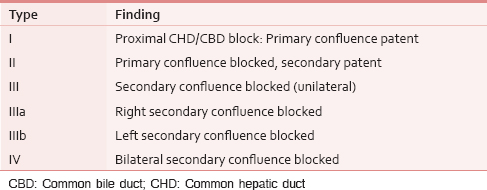
In this review article, authors discuss various intricacies of PTBD including biliary stenting and comparison with other biliary drainage options.
PERCUTANEOUS TRANSHEPATIC BILIARY DRAINAGE
PTBD is an image-guided procedure which can be performed under fluoroscopy or combined ultrasound and fluoroscopic guidance. Its indications are varied including both obstructive as well as nonobstructive etiologies.
Indications of PTBD for palliation in obstructive jaundice include:
-
Cholangitis
-
Pain alleviation
-
Pruritus
-
To decrease serum bilirubin before the initiation of chemotherapy
-
To access biliary system for further palliative interventions such as stent placement or transhepatic brachytherapy for cholangiocarcinoma.
Elevated serum bilirubin (>3 g/dl) clinically presents as jaundice. Hyperbilirubinemia impedes the initiation/continuation of chemotherapy in certain malignancies. Pruritus is a common accompaniment in malignant obstructive jaundice which may be disproportionate to the jaundice and usually alleviated by the drainage of even a single liver segment.
Pain and anorexia further deteriorate the quality of life which may be relieved to some extent by restoring physiological enterohepatic circulation by various drainage means (vide supra).[4567]
CONTRAINDICATION
-
Absolute
-
Uncorrectable bleeding diathesis.
-
-
Relative
-
INR >1.5
-
Platelet counts <50,000
-
Ascites
-
Multiple hepatic cysts.[8]
-
PREPROCEDURAL PATIENT'S PREPARATION
-
Adequate antibiotic coverage (preferably intravenous) should be instituted before and after the procedure, as manipulations in obstructed system carry the risk of cholangitis and sepsis
-
For pain alleviation, intravenous analgesics can be administered or optionally the procedure can be performed under conscious sedation
-
Patient should be preferably fasting or on clear liquid diets for at least 4 h prior to the procedure.
TECHNIQUE
Selection of appropriate target duct for biliary drainage
Prior to the initiation of procedure, three-dimensional cross-sectional imaging, i.e. computed tomography or magnetic resonance imaging of the patient needs to be reviewed to determine the following:
-
Site of obstruction – high or low. In proximal obstruction, primary biliary confluence may be blocked with variable involvement of secondary confluence. Low obstruction occurs beyond the level of primary biliary confluence (i.e., distal to cystic duct insertion). PTBD and ERCP are the preferred drainage procedures in high and low biliary obstructions, respectively
-
Selection of appropriate target duct in PTBD – right versus left PTBD
-
In case of involvement of biliary confluence, selected duct should drain at least one-sixth of the liver parenchyma. However, in distal obstruction, since primary biliary confluence is patent, a single puncture with placement of single drainage catheter usually suffices
-
There should be no atrophy or portal vein involvement of the targeted lobe as even after biliary drainage, liver function would not improve due to the lack of functioning hepatic parenchyma.
-
PTBD shall be formidable when cross-sectional imaging is not reviewed due to the observed lesser technical success rate of the procedure.[13]
The procedure can be performed either via right (subcostal or intercostal) or left ductal (subxiphoid) approach. Selection of appropriate sided duct (right or left) is a personal preference, although there are certain advantages and disadvantages of both [Tables 2 and 3]. Reviewing ultrasound prior to biliary puncture is invaluable for assessing the suitability of puncture as well as any contraindication to the procedure [Figure 1].



- Ultrasound in preprocedural workup (a) determining the level of obstruction and degree of intrahepatic biliary radical dilatation: Ultrasonography abdomen showing an ill-defined heterogeneously hypoechoic mass (arrow) at the porta hepatis blocking primary and bilateral secondary confluences with biliary radicles dilated till periphery (curved arrow), suitable for ultrasound-guided puncture, (b) Selection of target lobe: Excluding lobar atrophy (arrow) and portal venous thrombosis, (c) ruling out ascites (arrow), which is a relative contraindication
Left-sided percutaneous transhepatic biliary drainage
In case of suitably dilated biliary radicle dilatation, with an 18G puncture needle, under ultrasound guidance, appropriate segmental duct is punctured. In portal triad, biliary radicle is flanked by the branch of hepatic artery and portal vein, caliber of which increases toward the hepatic hilum. Due to this, site of puncture should be as peripheral as possible as more central puncture incurs more risk of major vascular injury [Figure 2].

- Approach to percutaneous transhepatic biliary drainage (a) right percutaneous transhepatic biliary drainage: Case of hilar cholangiocarcinoma: the right intrahepatic biliary radical punctured below the 10th rib to avoid pleura. After internalization with its distal tip in duodenum (arrow). Check cholangiogram showed opacification of bilobar intrahepatic biliary radical and duodenum suggesting optimal placement, (b) left percutaneous transhepatic biliary drainage: Case of periampullary carcinoma with failed endoscopic stent placement. Dilated left intrahepatic biliary radical punctured with negotiation of stricture and subsequent placement of ring biliary catheter (arrow)
When the outflow of bile starts, a 0.035 inch hydrophilic guide wire is passed through the puncture needle. Further, the malignant stricture is negotiated with the help of angiographic catheters and hydrophilic guide wires. During the procedure, intermittent check cholangiograms are done whenever needed to map the biliary anatomy, site of obstruction, and position of guide wire and catheters, keeping the contrast volume and concentration to minimum. In cases where the site of biliary obstruction is negotiated, a ring biliary catheter (8.3 Fr) is left on combined external and internal drainage for the initial few days with its tip in the duodenum beyond the ampulla [Figure 3]. After establishment of successful drainage, catheter is capped externally and left solely on internal drainage. In situations when the site of obstruction is not crossed, external drainage catheter is left in the biliary system for its decompression. Further attempts for internalization are done once there is reduction in the degree of biliary dilatation and subsidence of edema (usually after 3–7 days). Internalization is desirable as it restores the physiological enterohepatic circulation, thus preventing the loss of bile salts. Benefits and drawbacks of left-sided PTBD are tabulated below [Table 2].

- Types of biliary drainage: (a) External drainage: HC with proximal common hepatic duct obstruction. Left percutaneous transhepatic biliary drainage done, (b) unilateral internal-external drainage: Ca GB with bilobar intrahepatic biliary dilatation managed by the left percutaneous transhepatic biliary drainage and external-internal catheter placement, (c) bilateral internal-external drainage: HC with primary biliary confluence exclusion managed by bilateral percutaneous transhepatic biliary drainage and antegrade catheter placement, (d) internal drainage by endoprosthesis: Ca GB blocking primary biliary confluence. After initial percutaneous transhepatic biliary drainage, SEMS was placed. (HC: Hilar cholangiocarcinoma, Ca GB: Carcinoma gall bladder, SEMS: Self-expandable metallic stent)
Right-sided percutaneous transhepatic biliary drainage
Initial puncture is fluoroscopically guided, site is below the tenth rib in mid-axillary line (with 10° forward and cranial angulation of needle tip) to obviate pleural injury. Then, under fluoroscopic guidance, puncture needle is advanced for a length of approximately 3–4 cm, following which ultrasound guidance is resorted for further directing the needle to appropriate segmental duct. Remaining steps are similar as mentioned in the left PTBD (vide supra). A comparison of advantages and disadvantages of right-sided PTBD is compared below [Table 3 and Figure 2].
Postprocedural care
Patient should be admitted for a day to look for potential major complications, especially sepsis and hemobilia with continuation of antibiotics [Figure 4].

- Postprocedural management algorithm after percutaneous transhepatic biliary drainage
COMPLICATIONS OF PERCUTANEOUS TRANSHEPATIC BILIARY DRAINAGE
With increased expertise and better instrumentation, observed technical success rate of PTBD is ~90–95% with fewer complications observed nowadays. These complications can be further reduced by keeping the biliary manipulation to minimum and good antibiotic coverage.[9]
Minor
-
Pain
-
Pericatheter leak.
Major
-
Cholangitis, sepsis
-
Biliary peritonitis
-
Haemorrhage
-
Pancreatitis.
Pleural effusion, pneumothorax (inadvertent pleural puncture).
Catheter dislodgement is more common in external than internal drainage catheters due to better anchorage in the latter. It can be managed by repositioning or probing by a guide wire [Figure 5] through previous catheter's tract.[10]
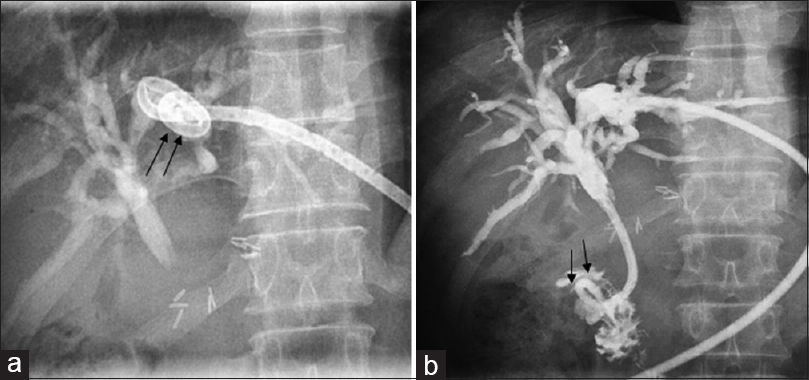
- Catheter dislodgement and repositioning (a) postoperative case of carcinoma gall bladder with recurrence at porta hepatis causing obstruction of proximal common bile duct, primary and bilateral biliary confluences were patent. Due to hyperbilirubinemia, the left percutaneous transhepatic biliary drainage was performed with the placement of internal-external catheter. Later on, due to decreased catheter output and pericatheter leak, cholangiogram was done which revealed dislodgement of the catheter with its migrated tip in the left-sided biliary radicle (arrows), (b) subsequently, guide wire manipulation was done and malignant stricture was negotiated, following which tip of the catheter was repositioned into the duodenum (arrow in b)
Pericatheter leak (bile leak along catheter) is a frequently observed complication [Figure 6a]. It can be due to side holes of catheter lying outside the biliary system, catheter kink/block, or ascites. Management in such cases consists of catheter repositioning or upgradation depending on the findings of check cholangiogram.
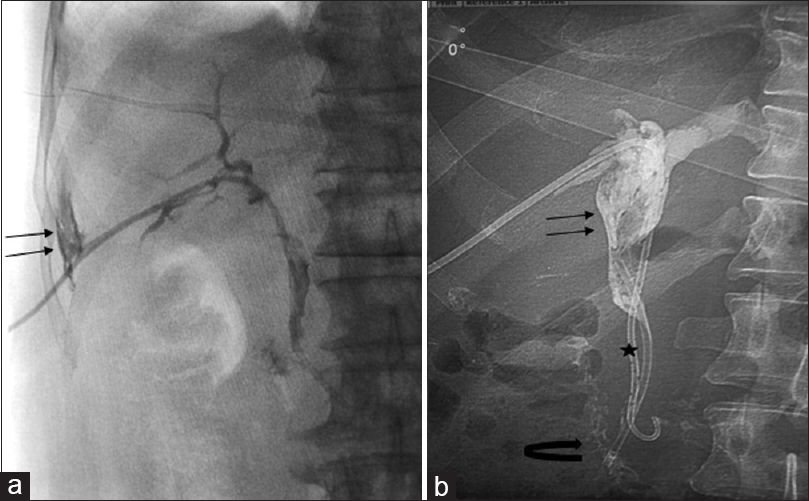
- (a) Pericatheter leak after the right percutaneous transhepatic biliary drainage for carcinoma gall bladder. Cholangiogram showed sliver of contrast along the right lobe of liver (arrow) as few side holes of drainage catheter were outside the biliary tree. After catheter repositioning, pericatheter leak subsided, (b) bleed inside the biliary tree following percutaneous transhepatic biliary drainage: Periampullary carcinoma with blocked endoscopic retrograde cholangiopancreatography stent (*). Right-sided percutaneous transhepatic biliary drainage done. Postprocedural check cholangiogram showed irregular cast-like filling defects in common bile duct and left ductal system with meager passage of contrast through its distal tip (curved arrow) into the duodenum s/o hemobilia
Cholangitis and biliary sepsis are inevitable complications which can occur despite adequate antibiotic coverage. Although exact etiology is unknown, it can occur due to multitude of factors such as retrograde reflux of intestinal flora during the procedure, ex vitro infection tracking along the drainage catheter, or may be of hematogenous origin. Prophylactically, broad spectrum intravenous antibiotics covering Gram-negative bacteria should be instituted. In addition, during the procedure, manipulations should be kept to minimum coupled with limited use of iodinated contrast during per procedural cholangiography. Symptomatic management should be done in such cases by continuing the antibiotics and maintaining the fluid balance.[110]
Hemorrhage/hemobilia after PTBD is usually transient and is less commonly seen with more peripheral biliary radicle puncture [Figure 6b]. As hepatic artery and portal vein also accompany the dilated biliary radicle, side holes of the drainage catheter may get positioned in these vascular structures, which can be corrected by catheter repositioning.[13]
Sudden onset or hemobilia occurring 1–2 weeks after the procedure is usually due to arterial injury (active extravasation or pseudoaneurysm), especially if it is pulsatile and there is pericatheter hemorrhage. Angiography needs to be done in such cases followed by embolization of bleeding artery [Figure 7].[3]

- Post percutaneous transhepatic biliary drainage bleed due to pseudoaneurysm: (a) Carcinoma gall bladder with bilobar intrahepatic biliary dilatation. Two weeks after right percutaneous transhepatic biliary drainage and external drainage catheter placement in common hepatic duct (curved arrow), the patient presented with shock and frank pulsatile bleeding. Celiac axis (arrow) angiogram showed no contrast extravasation or pseudoaneurysm (*angiographic catheter) (b) superselective catheterization of the left hepatic artery revealed a pseudoaneurysm (arrows) (c) exclusion of pseudoaneurysm with coil embolization (arrow) (d) postprocedural angiography showing obliteration of pseudoaneurysm (arrow)
In both proximal and distal biliary obstructions, PTBD complications are similar; however, incidence is higher in cases of proximal (hilar) block due to following reasons
-
Increased risk of cholangitis: Due to inadvertent contrast injection into nondraining segment during cholangiograms
-
Less technical success: PTBD is more demanding in hilar block with lesser chances of internalization in the first attempt and increased risk of catheter dislodgement.[1]
BILIARY STENTING
Biliary stenting can be performed endoscopically, percutaneously, or by the combined means. Biliary stents can be either plastic or metallic, selection of which depends on the etiology of biliary obstruction (benign vs. malignant), life expectancy, and affordability.
Metallic stents
In cases which aim palliation such as unresectable malignancies, self-expandable metallic stents (SEMS) are preferred for permanent stenting over plastic stents due to better patency. If there is occlusion of stent due to tumor ingrowth, then another stent or external/internal drainage catheter can be placed through it without the need of removal.[131112]
Percutaneous biliary stenting should be contemplated as a staged procedure after initial biliary decompression when there is subsidence of risk of cholangitis/sepsis. After few days (about a week or later) of preliminary decompression, check cholangiogram is done to look for degree of biliary dilatation as well as site of stent placement. In conducive situations, stents are placed into the biliary system covering the tumor. Subsequent to the successful stenting, percutaneous transhepatic drainage catheter is removed, thus alleviating the catheter-related potential complications (vide supra).[1]
SELECTION OF BILIARY RADICLE/SEGMENT FOR ADEQUATE BILIARY DRAINAGE: DIFFERENCE IN APPROACH IN CATHETER DRAINAGE VERSUS METALLIC BILIARY STENTING
As mentioned vide supra that for percutaneous catheter drainage, selection of biliary access (right vs. left) depends on the volume of lobe, status of portal vein and cholangitis. Due to its large volume, usually, the right PTBD is preferred with an intent to salvage the functioning liver parenchyma. However, the right segmental ducts are shorter as compared to the left-sided ducts. As a corollary, further growth of malignancies will lead to proportionately more severe involvement of the right duct. In general, depending on the type of hilar block, the following approach is followed [Table 4] for stent placement.[1314]
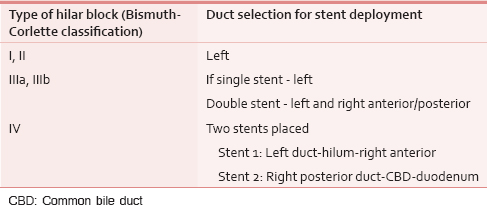
Types and configuration of metallic biliary stenting
Required number and configuration of stents depend on the degree (primary vs. secondary biliary confluence block) of biliary obstruction and the presence of cholangitis [Figure 8].
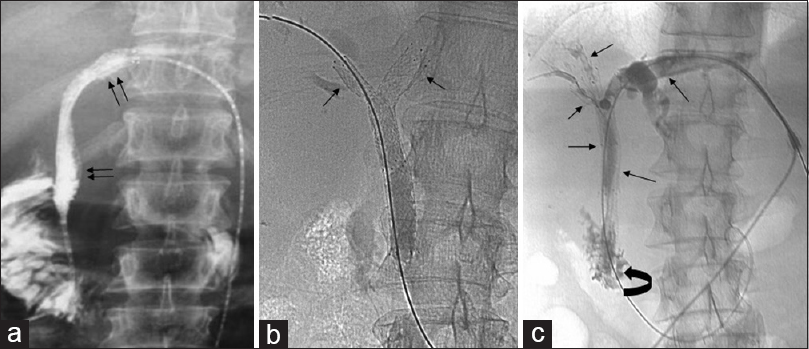
- Types of biliary stenting (a) Single stent: carcinoma gall bladder with blocked primary biliary confluence. Single stent (arrows) placed through the left ductal approach (b) bilateral stents: Performed in blocked secondary biliary confluences (unilateral or bilateral). Two biliary stents (arrow) seen encompassing the hilum, draining the left and right anterior sectoral duct (c) multiple stents: Type IV hilar cholangiocarcinoma causing isolation of major segmental ducts. Stents can be seen draining left, right anterior, and posterior sectoral ducts into common bile duct. One of the stents is seen draining into duodenum (curved arrow)
-
Single stent - when the site of obstruction is at or beyond the level of primary biliary confluence. If primary biliary confluence is patent, stenting can be done either from a right- or left-sided ductal access. However, if primary confluence is blocked, stent should be placed through the side being more affected or drains larger segment of liver
-
Bilateral stents - They are indicated when secondary confluence (either unilateral or bilateral) is blocked (Bismuth Corlette – III and IV)
-
Multiple stents - They may be required in Type IV block when more than one major segmental duct's drainage is required to lower bilirubin or if cholangitis ensues.[111215]
Configuration of biliary stents
Most of the biliary tract malignancies are usually managed by a single stent, especially when primary confluence is patent. However, when there is isolation of right and left segmental ducts, adequate biliary drainage may require bilateral stenting. Biliary stenting contemplated in hilar malignancies (Type IV block) for bilateral biliary drainage can be configured in two ways - “Y and T configuration [Figure 9].[1215]”
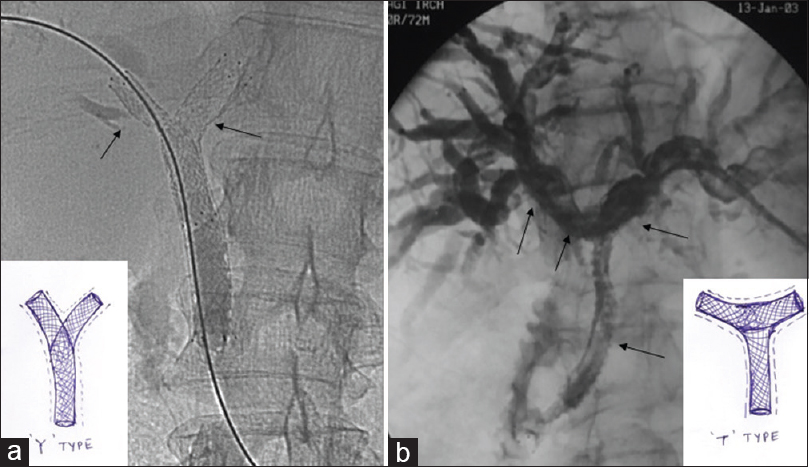
- Configuration of metallic biliary stents (a) Y-shaped: Initial bilateral percutaneous biliary access followed by the deployment of metallic stent bilaterally. Performed in Type III or IV block (b) T-shaped: Left sided percutaneous access was gained followed by placement of the first stent horizontally from left to right hepatic duct across the hilum. Another stent is then placed vertically through the mesh of the previous one connecting the transverse/ horizontal stent to the CBD. Inset in A and B depicting pictorial representation. Y configuration is preferred in acute hilar angle whereas T configuration is preferred in obtuse hilar angle
Y-shaped
It is the most preferred stent configuration in which bilateral (both right- and left-sided) percutaneous biliary access is achieved. The first stent is then placed through one of the access with its proximal and distal tip in the ipsilateral hepatic duct and duodenum, respectively. After this, with the contralateral biliary access, other SEMS is introduced through the mesh of the first one with its positioning remaining same; however, its proximal tip is in the contralateral hepatic duct. This configuration aims to restore the normal biliary anatomy for drainage.
T-shaped
In this configuration, bilateral stenting can be performed even through the unilateral biliary access. Here, for instance if left PTBD is done, the first SEMS is placed in a horizontal configuration from left to right hepatic duct. The second SEMS is then placed connecting the transverse stent to the CBD in vertical configuration. Although T configuration offers the advantage of bilobar drainage through a single puncture; however, in case of stent block, subsequent re-intervention is comparatively easier in the Y configuration.
Plastic stents
Plastic stent is preferred in benign causes as it can be retrieved subsequently which is not the option in metallic stents. In certain malignancies such as lymphoma (leading to biliary obstruction) or in hilar block with multiple isolated biliary segments, plastic stenting can be done.[15]
Complications of biliary stenting
Apart from the possible complications of initial PTBD (mentioned above), specific stent-related adversities may occur which are usually delayed events such as stent occlusion, block, or migration. Stent occlusion occurs due to either tumor ingrowth through its struts or tumor overgrowth either proximal or distal to the stent. Comparing the likelihood of occlusion of plastic and metallic stents, the latter scores with its longer patency rates [Table 5].[131416]
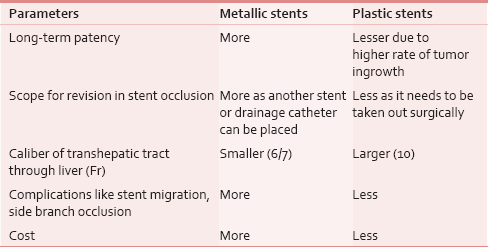
Median patency of the biliary stents depends on its type, i.e., plastic versus metallic, covered or uncovered, its caliber, site of malignant occlusion, and concomitant intraluminal brachytherapy administration. In general, if stenting aims palliation, then plastic stents are used if expected survival is <3–4 months, otherwise metallic stents are used as the former is relatively cheaper. In most series, 30-day mortality is >10%, median survival being 10 months, and most patients die due to the underlying malignancy. Mean patency rate of SEMS is 6–9 months with an occlusion rate of 30–40% by 6 months. Stent occlusion requiring re-intervention occurs in ~10–30% of the cases.[11121517]
In a study conducted by one of the authors, median stent patency was 147 days. In general, patency rate of stent is higher than internal-external drainage (ring biliary) catheter likely due to its larger caliber, less chances of blockage due to infections as they are not exposed externally, and no accidental dislodgement unlike ring biliary catheter.[17]
The cost of procedure including hospitalization varies from hospital to hospital, whether government or private. The cost of biliary stent is approximately 30,000–70,000 Indian rupees. The cost of hardware (other than stent) for PTBD procedure is approximately 10,000–15,000 Indian rupees. Hospitalization charges vary significantly from government to private hospitals or centers.
ENDOSCOPIC RETROGRADE CHOLANGIOPANCREATOGRAPHY
ERCP with placement of plastic stent (polyethylene endoprosthesis) is another effective method of biliary drainage. It is the preferred procedure in cases of obstruction beyond the level of hilum, i.e. if the primary biliary confluence is patent as adequate biliary drainage can be accomplished by the placement of single stent. Furthermore, in such cases of low biliary obstruction, ERCP is preferred, as it is a safer procedure in comparison to PTBD.[181920]
CONTRAINDICATIONS TO ENDOSCOPIC RETROGRADE CHOLANGIOPANCREATOGRAPH
Absolute
Relative
-
Acute pancreatitis
-
Severe cardiopulmonary disease
-
Failure to cannulate duodenal papilla: Previous roux-en-Y surgery (distortion of ampullary anatomy) and duodenal stenosis.
ENDOSCOPIC (ENDOSCOPIC RETROGRADE CHOLANGIOPANCREATOGRAPHY) VERSUS PERCUTANEOUS DRAINAGE (PERCUTANEOUS TRANSHEPATIC BILIARY DRAINAGE)
In inoperable malignancies causing biliary obstruction, ERCP with placement of plastic endoprosthesis or PTBD with metallic stenting remains the minimally invasive options. However, choosing a procedure over other depends on the level of obstruction, operator's expertise, and the level of postprocedural care provided to the patient.
Distal biliary obstruction
ERCP is unambiguously the preferred procedure worldwide as it is a comparably safer procedure with relatively fewer contraindications. Unlike PTBD, burden of percutaneous drainage catheter and bag is obviated which further compounds the psychological burden of terminally ill patients. In the current scenario, in cases of distal CBD obstruction, ERCP is the preferred technique unless contraindicated (vide supra), for which PTBD is done.[2324]
Proximal biliary obstruction
Opinion is divided regarding the choice of technique with nearly comparable results regarding overall patient's survival and procedure-related complication. However, at many institutions, PTBD is preferred in hilar isolation as ultrasound-guided puncture of appropriate segmental biliary radicle can be done, thus maximizing the drainage of functioning liver parenchyma. Further, malignant stricture is better negotiated in PTBD and the risk of inadvertent contrast instillation into isolated biliary segment is lesser as compared to ERCP.[317252627]
Various studies comparing PTBD and ERCP in distal CBD block have reported that both these procedures have nearly equivalent technical success rate with comparable incidences of procedure-related complications and mortality [Table 6].[1] The American College of Radiology (ACR) has recently proposed an evidence-based algorithmic approach for radiological management of malignant biliary obstruction. In the proposed criteria, various management options are rated based on their appropriateness for particular site of obstruction [Table 7]. In general, as per the ACR recommendations of the various management options, PTBD is preferred for hilar block whereas ERCP with stenting in distal block.
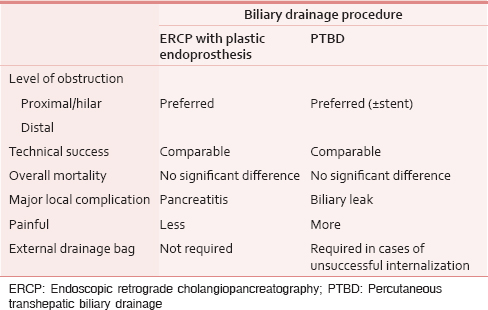
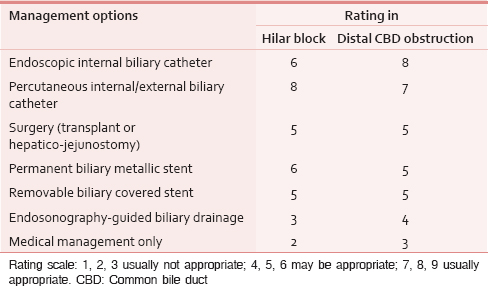
ACR Appropriateness Criteria®: Management of Benign and Malignant Biliary Obstruction, 2012 review [Table 8].

CONCLUSION
Due to recent advances in the procedural technique coupled with better hardware's availability, there has been a significant reduction in the overall morbidity and mortality (short-term) in cases of malignant obstructive jaundice. However, long-term prognosis remains dismal in malignant obstructive jaundice due to relentless dragging evolution of primary malignancy. Nonetheless, in the current scenario, PTBD is the recommended standard of palliative care for cases of obstructive jaundice as it improves the quality of life with definite immediate survival benefits.
Financial support and sponsorship
Nil.
Conflicts of interest
There are no conflicts of interest.
REFERENCES
- Percutaneous drainage and stenting for palliation of malignant bile duct obstruction. Eur Radiol. 2008;18:448-56.
- [Google Scholar]
- Percutaneous transhepatic biliary drainage in patients with advanced solid malignancies: Prognostic factors and clinical outcomes. J Gastrointest Cancer. 2013;44:398-403.
- [Google Scholar]
- Percutaneous transhepatic biliary drainage. Tech Vasc Interv Radiol. 2008;11:14-20.
- [Google Scholar]
- Palliation of malignant biliary obstruction: A prospective trial examining impact on quality of life. Gastrointest Endosc. 2002;56:835-41.
- [Google Scholar]
- Symptom relief and quality of life after stenting for malignant bile duct obstruction. Gut. 1994;35:467-70.
- [Google Scholar]
- Clinical impact of biliary drainage and jaundice resolution in patients with obstructive metastases at the hilum. Am J Gastroenterol. 2003;98:1271-7.
- [Google Scholar]
- Anorexia and the effect of internal biliary drainage on food intake in patients with obstructive jaundice. J Am Coll Surg. 2001;192:584-90.
- [Google Scholar]
- Percutaneous management of biliary obstruction. In: Gazelle GS, Saini S, Mueller PR, eds. Hepatobiliary and Pancreatic Radiology Imaging and Intervention. New York: Thieme; 1998. p. :677-709.
- [Google Scholar]
- Quality improvement guidelines for percutaneous transhepatic cholangiography and biliary drainage. J Vasc Interv Radiol. 2003;14(9 Pt 2):S243-6.
- [Google Scholar]
- Comparison of infection between internal-external and external percutaneous transhepatic biliary drainage in treating patients with malignant obstructive jaundice. Asian Pac J Cancer Prev. 2015;16:2543-6.
- [Google Scholar]
- Metallic stents in malignant biliary obstruction: Results of a multicenter European study of 240 patients. J Vasc Interv Radiol. 1994;5:279-85.
- [Google Scholar]
- Malignant biliary obstruction: Treatment with self-expandable stainless steel endoprosthesis. Cardiovasc Intervent Radiol. 1992;15:351-5.
- [Google Scholar]
- Failed metallic biliary stents: Causes and management of delayed complications. Clin Radiol. 1994;49:857-62.
- [Google Scholar]
- Malignant biliary obstruction: Percutaneous use of self-expandable stents. Radiology. 1991;179:703-7.
- [Google Scholar]
- Plastic endoprostheses versus metal stents in the palliative treatment of malignant hilar biliary obstruction. A prospective and randomized trial. Endoscopy. 1993;25:213-8.
- [Google Scholar]
- Complications of percutaneously inserted biliary Wallstents. J Vasc Interv Radiol. 1993;4:767-72.
- [Google Scholar]
- Unilobar versus bilobar biliary drainage: Effect on quality of life and bilirubin level reduction. Indian J Palliat Care. 2016;22:50-62.
- [Google Scholar]
- Biliary stenting versus bypass surgery for the palliation of malignant distal bile duct obstruction: A meta-analysis. Liver Transpl. 2000;6:302-8.
- [Google Scholar]
- Endoscopic palliation of patients with biliary obstruction caused by nonresectable hilar cholangiocarcinoma: Efficacy of self-expandable metallic Wallstents. Gastrointest Endosc. 2002;56:33-9.
- [Google Scholar]
- Management of malignant hilar biliary obstruction by endoscopy. Results and prognostic factors. Dig Dis Sci. 1992;37:778-83.
- [Google Scholar]
- Complications related to endoscopic retrograde cholangiopancreatography: A comprehensive clinical review. J Gastrointestin Liver Dis. 2009;18:73-82.
- [Google Scholar]
- Randomised trial of endoscopic versus percutaneous stent insertion in malignant obstructive jaundice. Lancet. 1987;2:57-62.
- [Google Scholar]
- Carcinoma of the hepatic confluence 25 years after Klatskin's description: Diagnosis and endoscopic management. Semin Liver Dis. 1990;10:102-13.
- [Google Scholar]
- Endoscopically inserted biliary endoprosthesis in malignant obstructive jaundice. A survey of the literature. Liver. 1990;10:321-4.
- [Google Scholar]
- Percutaneous palliation of unresectable pancreatic cancer. Surg Clin North Am. 1995;75:989-99.
- [Google Scholar]






